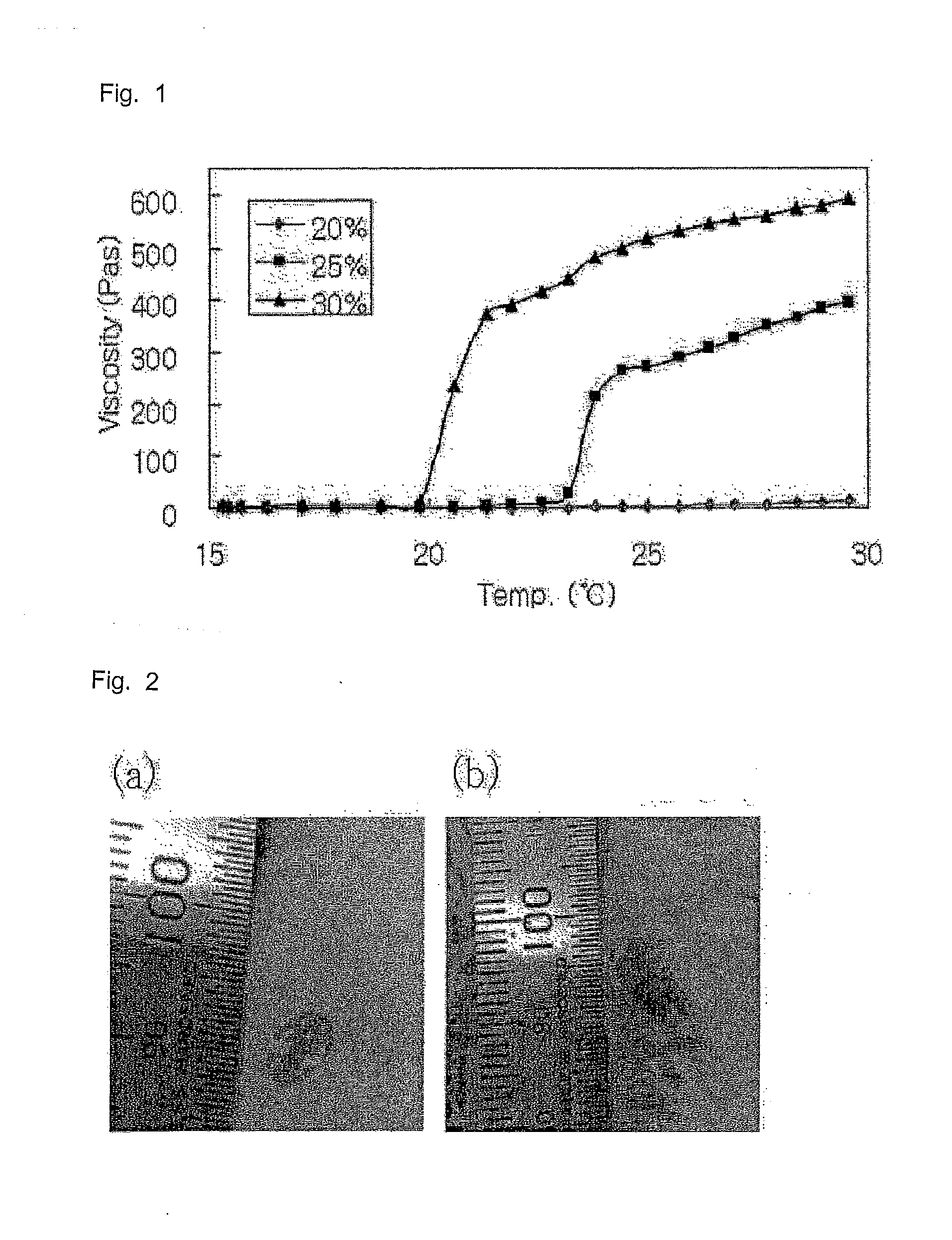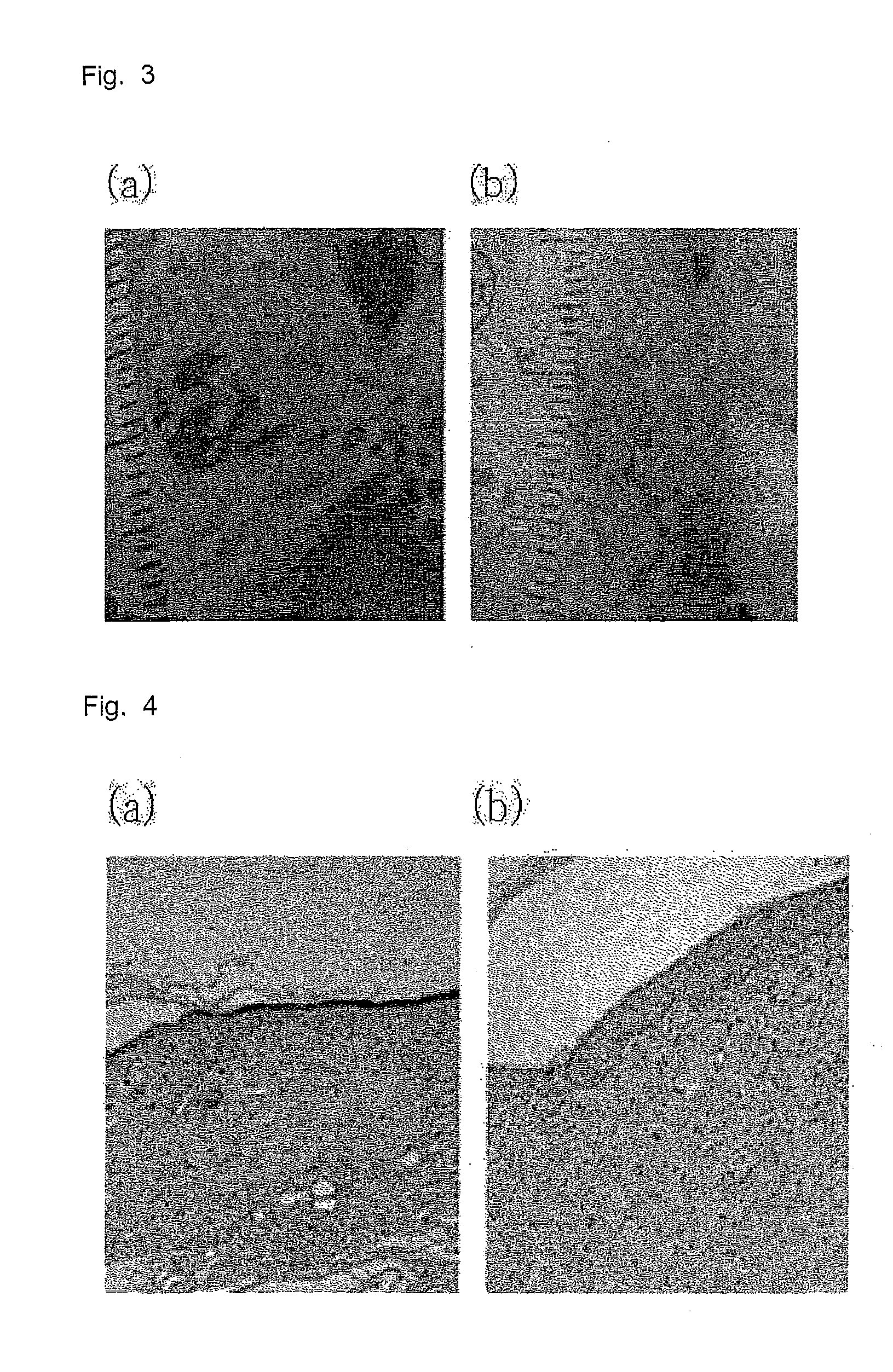Hydrogel Type Cell Delivery Vehicle for Wound Healing, and Preparation Method Thereof
- Summary
- Abstract
- Description
- Claims
- Application Information
AI Technical Summary
Benefits of technology
Problems solved by technology
Method used
Image
Examples
example 1
[0040]In 50 μL of physiological saline, 12 pmoles of Substance-p and 100 mg of Pluronic F127 (BASF) were mixed to give a hydrogel. Balb / c nude mice (male, 5 weeks old) were injured to produce wounds 8 mm in diameter on their backs. The hydrogel was applied to the wounds while physiological saline was used as a control. Day 7 after application, the wounds were examined with the naked eye. FIG. 2 shows wounds observed with the naked eye on Day 7 after the application of the control (a) and the hydrogel comprising Substance-P (b). As seen, the hydrogel of the present invention exerted a wetting effect on the wound and suppressed the contraction of the wound, thus effectively promoting wound healing, compared to the control.
[0041]In 10 mL of physiological saline were dissolved 2 g, 2.5 g and 3 g of Pluronic F127 to prepare 20%, 25% and 30% hydrogels, respectively. These hydrogels were monitored for change in viscosity with temperature (15-30° C.) using a rheometer (CVO, BOHLIN Instrumen...
example 2
[0042]In 50 μL of a mesenchymal stem cell (MSC) growth medium (MSCGM), 1×106 mesenchymal stem cells and 100 mg of Pluronic F127 were mixed to give a hydrogel. To an 8 mm-diameter wound formed on the back of a Balb / c nude mouse (male, 5 weeks old) was applied 50 μL of the hydrogel while physiological saline was used as a control. On Day 6 after application, the same hydrogel was applied again. On Day 14 after the initial application, the wounds on the back of the mice were observed with the naked eye and examined histologically. FIG. 3 shows the wounds observed with the naked eye on Day 14 after the application of the control (a) and the hydrogel comprising mesenchymal stem cells (b). FIG. 4 shows histological observations of the wounds on Day 14 after the control (a) and the hydrogel comprising mesenchymal stem cells (b) were applied. As seen from the observations with the naked eye, the hydrogel of the present invention exerted a wetting effect on the wound and suppressed the contr...
example 3
[0043]In 50 μL of a skin cell culture medium (DMEM), 5×105 skin cells (fibroblasts, keratinocytes and pigment cells) and 100 mg of Pluronic F127 were mixed to give a hydrogel. To an 8 mm-diameter wound formed on the back of a Balb / c nude mouse (male, 5 weeks old) was applied 50 μL of the hydrogel while physiological saline was used as a control. On Day 7 after application, the wounds on the back of the mice were observed with the naked eye and examined histologically. FIG. 5 shows the wounds observed with the naked eye on Day 7 after the control (a) and the hydrogel comprising skin cells (b) were applied. FIG. 6 shows histological observations of the wounds on Day 7 after the control (a) and the hydrogel comprising skin cells (b) were applied. As seen from the observations with the naked eye, the hydrogel of the present invention exerted a wetting effect on the wound and suppressed the contraction of the wound, thus effectively promoting wound healing, compared to the control. In ad...
PUM
| Property | Measurement | Unit |
|---|---|---|
| Weight | aaaaa | aaaaa |
Abstract
Description
Claims
Application Information
 Login to View More
Login to View More - R&D
- Intellectual Property
- Life Sciences
- Materials
- Tech Scout
- Unparalleled Data Quality
- Higher Quality Content
- 60% Fewer Hallucinations
Browse by: Latest US Patents, China's latest patents, Technical Efficacy Thesaurus, Application Domain, Technology Topic, Popular Technical Reports.
© 2025 PatSnap. All rights reserved.Legal|Privacy policy|Modern Slavery Act Transparency Statement|Sitemap|About US| Contact US: help@patsnap.com



